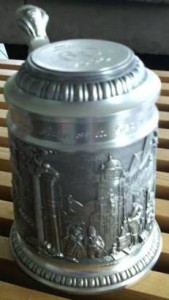Krug or Steinkrug (Beer Stein)
Date of Creation: Early 1800s
Materials: Silver
Arrival in Dunedin: 1983
Description: Silver, design of Stuttgart, flat top, holds half a litre or 17.6 fluid ounces
Researcher: Sean Neilson
History:
A Krug is a vessel used for drinking beer, the earliest of which date from 1525. This Krug is a family heirloom belonging to the Schultz family that has been passed from father to son through the generations since the early 1800s. The Schultz family brought it with them to Dunedin in 1983 after brief stays in Canada and South Africa.
Significance:
The Krug is traditionally seen as a status symbol and is often given as a gift from father to son. After the Bubonic Plague swept through central Europe in the mid to late 1300s, people became very aware of diseases transported by insects. By the early 1500s, several territories in what is now Germany had passed laws requiring that all food and beverage containers be covered. The common mug had to be covered, and this was accomplished by adding a hinged lid with a thumb-lift. This ingenious invention was soon used to cover all German beverage containers while still allowing them to be used with one hand.

